Business and Business Environment: Merrill Lynch Report and Analysis
VerifiedAdded on 2021/02/21
|21
|6698
|25
Report
AI Summary
This report provides a comprehensive analysis of the business environment, focusing on the different types and purposes of organizations, including public, private, and voluntary sectors, along with their respective legal structures. The report utilizes Merrill Lynch as a case study to illustrate the size and scope of organizations within the private sector, detailing its objectives and functions. Furthermore, the report examines the relationships between organizational functions and objectives. It also conducts an internal and external analysis of Merrill Lynch, employing PESTEL analysis to identify the positive and negative impacts of the macro environment on business operations and how strengths and weaknesses interrelate with these external factors. Finally, the report provides a conclusion that synthesizes the key findings and insights presented throughout the analysis.
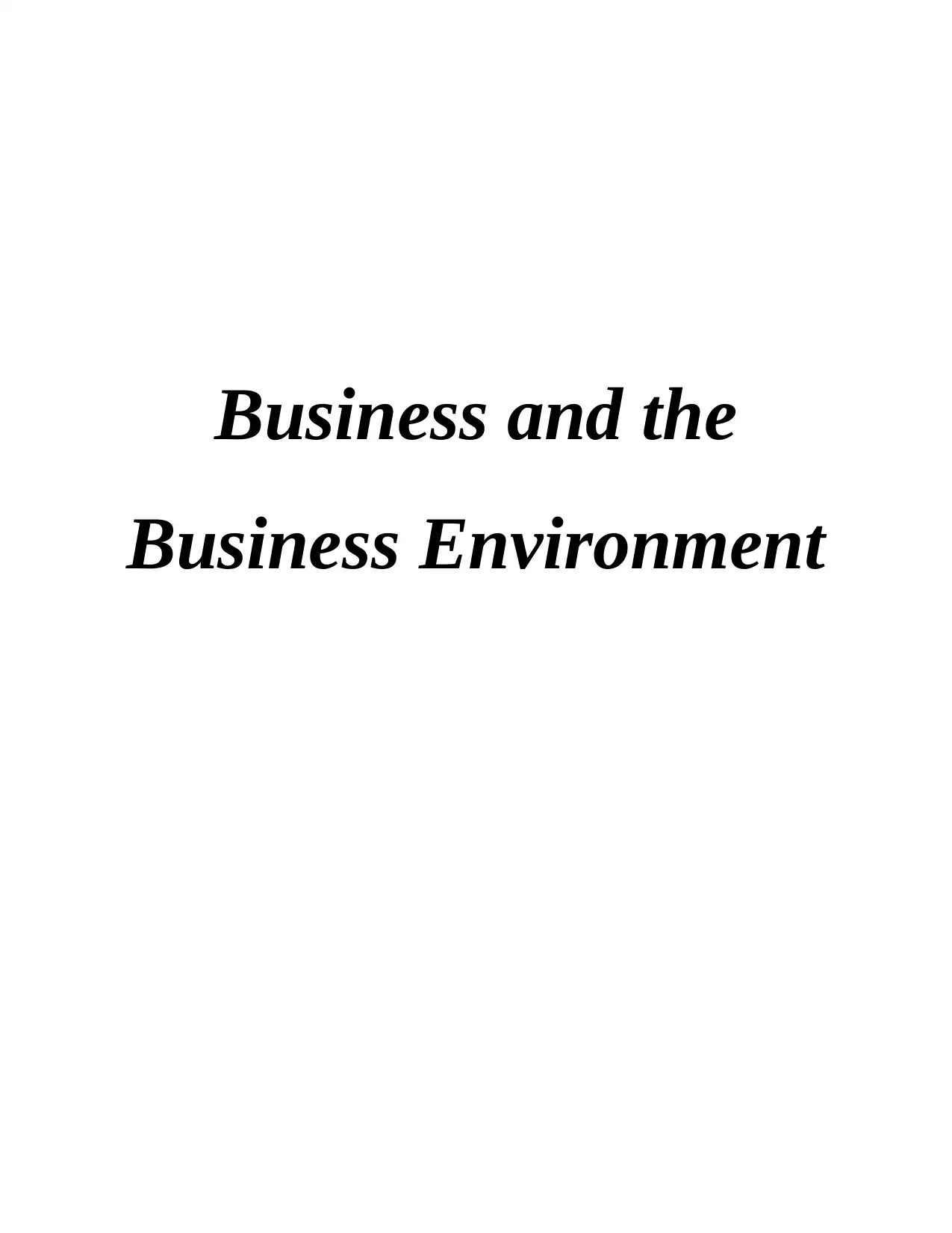
Business and the
Business Environment
Business Environment
Paraphrase This Document
Need a fresh take? Get an instant paraphrase of this document with our AI Paraphraser
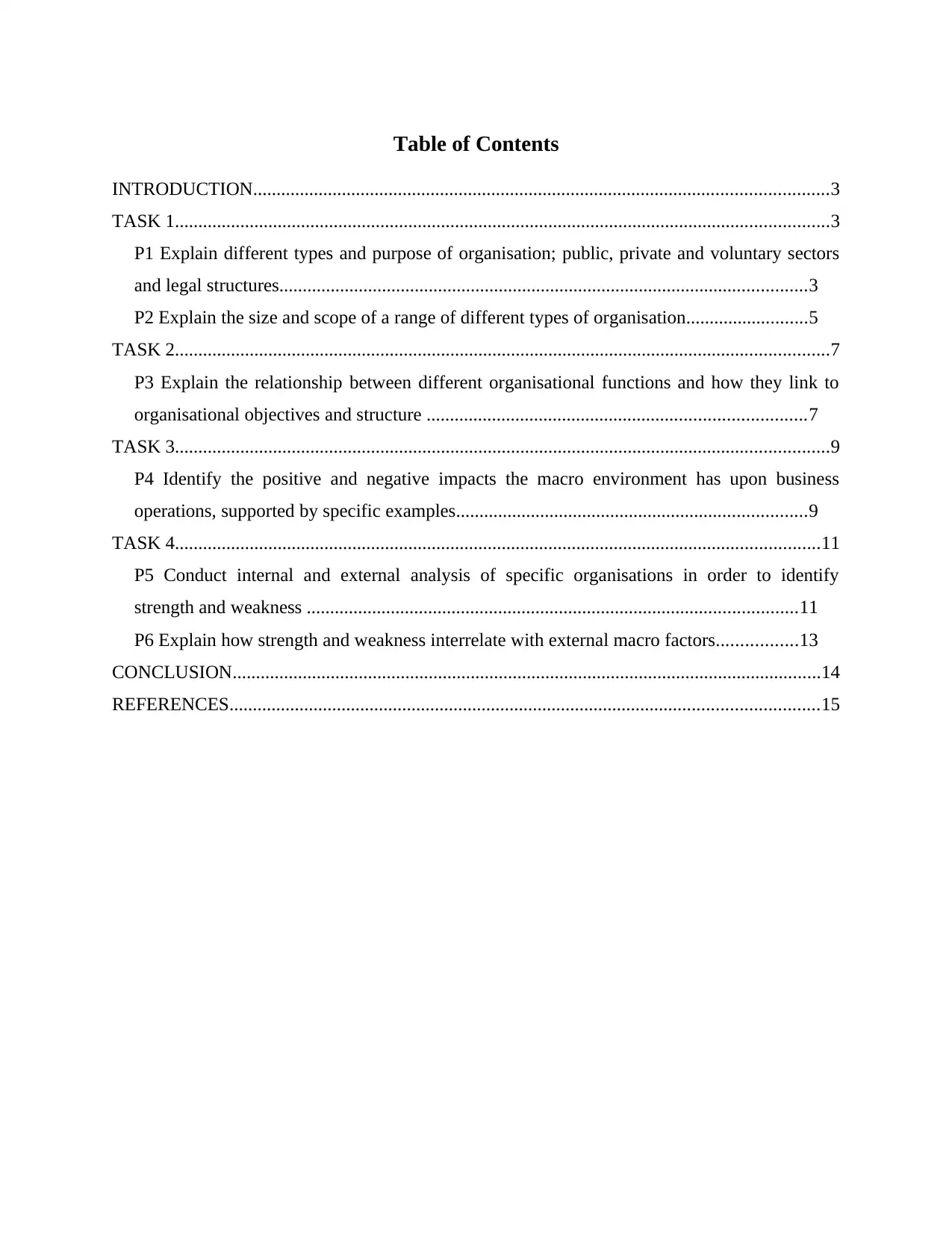
Table of Contents
INTRODUCTION...........................................................................................................................3
TASK 1............................................................................................................................................3
P1 Explain different types and purpose of organisation; public, private and voluntary sectors
and legal structures.................................................................................................................3
P2 Explain the size and scope of a range of different types of organisation..........................5
TASK 2............................................................................................................................................7
P3 Explain the relationship between different organisational functions and how they link to
organisational objectives and structure .................................................................................7
TASK 3............................................................................................................................................9
P4 Identify the positive and negative impacts the macro environment has upon business
operations, supported by specific examples...........................................................................9
TASK 4..........................................................................................................................................11
P5 Conduct internal and external analysis of specific organisations in order to identify
strength and weakness .........................................................................................................11
P6 Explain how strength and weakness interrelate with external macro factors.................13
CONCLUSION..............................................................................................................................14
REFERENCES..............................................................................................................................15
INTRODUCTION...........................................................................................................................3
TASK 1............................................................................................................................................3
P1 Explain different types and purpose of organisation; public, private and voluntary sectors
and legal structures.................................................................................................................3
P2 Explain the size and scope of a range of different types of organisation..........................5
TASK 2............................................................................................................................................7
P3 Explain the relationship between different organisational functions and how they link to
organisational objectives and structure .................................................................................7
TASK 3............................................................................................................................................9
P4 Identify the positive and negative impacts the macro environment has upon business
operations, supported by specific examples...........................................................................9
TASK 4..........................................................................................................................................11
P5 Conduct internal and external analysis of specific organisations in order to identify
strength and weakness .........................................................................................................11
P6 Explain how strength and weakness interrelate with external macro factors.................13
CONCLUSION..............................................................................................................................14
REFERENCES..............................................................................................................................15
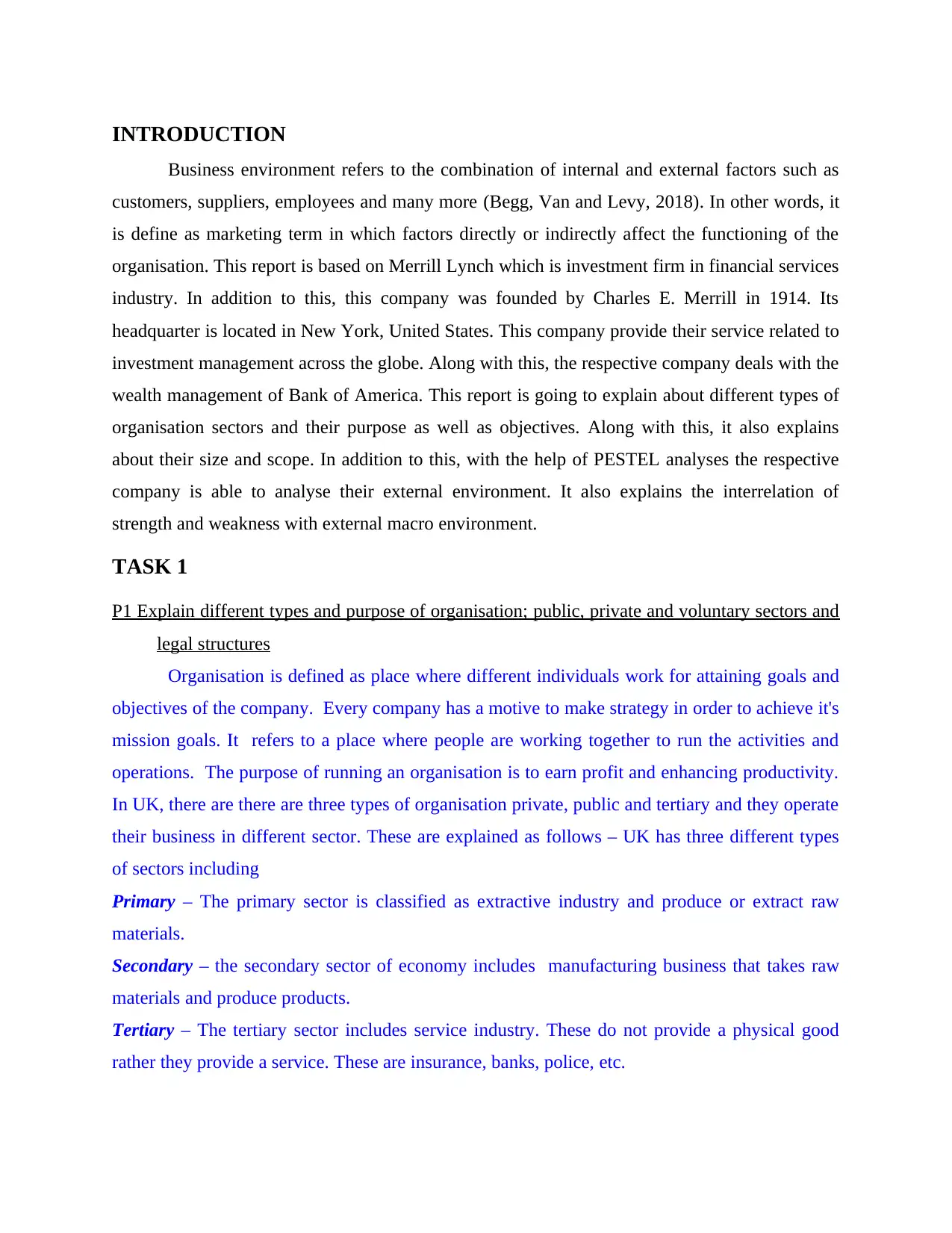
INTRODUCTION
Business environment refers to the combination of internal and external factors such as
customers, suppliers, employees and many more (Begg, Van and Levy, 2018). In other words, it
is define as marketing term in which factors directly or indirectly affect the functioning of the
organisation. This report is based on Merrill Lynch which is investment firm in financial services
industry. In addition to this, this company was founded by Charles E. Merrill in 1914. Its
headquarter is located in New York, United States. This company provide their service related to
investment management across the globe. Along with this, the respective company deals with the
wealth management of Bank of America. This report is going to explain about different types of
organisation sectors and their purpose as well as objectives. Along with this, it also explains
about their size and scope. In addition to this, with the help of PESTEL analyses the respective
company is able to analyse their external environment. It also explains the interrelation of
strength and weakness with external macro environment.
TASK 1
P1 Explain different types and purpose of organisation; public, private and voluntary sectors and
legal structures
Organisation is defined as place where different individuals work for attaining goals and
objectives of the company. Every company has a motive to make strategy in order to achieve it's
mission goals. It refers to a place where people are working together to run the activities and
operations. The purpose of running an organisation is to earn profit and enhancing productivity.
In UK, there are there are three types of organisation private, public and tertiary and they operate
their business in different sector. These are explained as follows – UK has three different types
of sectors including
Primary – The primary sector is classified as extractive industry and produce or extract raw
materials.
Secondary – the secondary sector of economy includes manufacturing business that takes raw
materials and produce products.
Tertiary – The tertiary sector includes service industry. These do not provide a physical good
rather they provide a service. These are insurance, banks, police, etc.
Business environment refers to the combination of internal and external factors such as
customers, suppliers, employees and many more (Begg, Van and Levy, 2018). In other words, it
is define as marketing term in which factors directly or indirectly affect the functioning of the
organisation. This report is based on Merrill Lynch which is investment firm in financial services
industry. In addition to this, this company was founded by Charles E. Merrill in 1914. Its
headquarter is located in New York, United States. This company provide their service related to
investment management across the globe. Along with this, the respective company deals with the
wealth management of Bank of America. This report is going to explain about different types of
organisation sectors and their purpose as well as objectives. Along with this, it also explains
about their size and scope. In addition to this, with the help of PESTEL analyses the respective
company is able to analyse their external environment. It also explains the interrelation of
strength and weakness with external macro environment.
TASK 1
P1 Explain different types and purpose of organisation; public, private and voluntary sectors and
legal structures
Organisation is defined as place where different individuals work for attaining goals and
objectives of the company. Every company has a motive to make strategy in order to achieve it's
mission goals. It refers to a place where people are working together to run the activities and
operations. The purpose of running an organisation is to earn profit and enhancing productivity.
In UK, there are there are three types of organisation private, public and tertiary and they operate
their business in different sector. These are explained as follows – UK has three different types
of sectors including
Primary – The primary sector is classified as extractive industry and produce or extract raw
materials.
Secondary – the secondary sector of economy includes manufacturing business that takes raw
materials and produce products.
Tertiary – The tertiary sector includes service industry. These do not provide a physical good
rather they provide a service. These are insurance, banks, police, etc.
⊘ This is a preview!⊘
Do you want full access?
Subscribe today to unlock all pages.

Trusted by 1+ million students worldwide
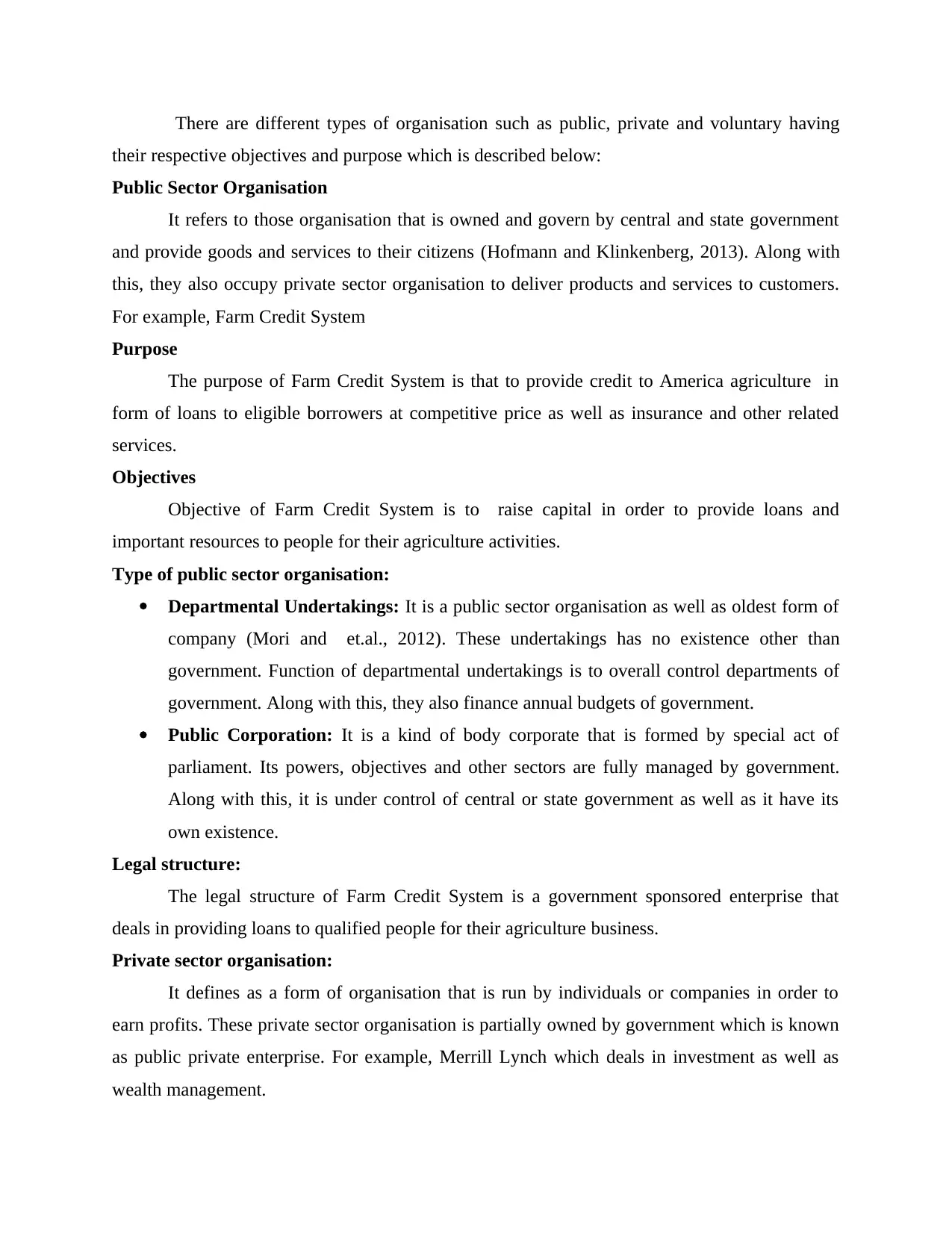
There are different types of organisation such as public, private and voluntary having
their respective objectives and purpose which is described below:
Public Sector Organisation
It refers to those organisation that is owned and govern by central and state government
and provide goods and services to their citizens (Hofmann and Klinkenberg, 2013). Along with
this, they also occupy private sector organisation to deliver products and services to customers.
For example, Farm Credit System
Purpose
The purpose of Farm Credit System is that to provide credit to America agriculture in
form of loans to eligible borrowers at competitive price as well as insurance and other related
services.
Objectives
Objective of Farm Credit System is to raise capital in order to provide loans and
important resources to people for their agriculture activities.
Type of public sector organisation:
Departmental Undertakings: It is a public sector organisation as well as oldest form of
company (Mori and et.al., 2012). These undertakings has no existence other than
government. Function of departmental undertakings is to overall control departments of
government. Along with this, they also finance annual budgets of government.
Public Corporation: It is a kind of body corporate that is formed by special act of
parliament. Its powers, objectives and other sectors are fully managed by government.
Along with this, it is under control of central or state government as well as it have its
own existence.
Legal structure:
The legal structure of Farm Credit System is a government sponsored enterprise that
deals in providing loans to qualified people for their agriculture business.
Private sector organisation:
It defines as a form of organisation that is run by individuals or companies in order to
earn profits. These private sector organisation is partially owned by government which is known
as public private enterprise. For example, Merrill Lynch which deals in investment as well as
wealth management.
their respective objectives and purpose which is described below:
Public Sector Organisation
It refers to those organisation that is owned and govern by central and state government
and provide goods and services to their citizens (Hofmann and Klinkenberg, 2013). Along with
this, they also occupy private sector organisation to deliver products and services to customers.
For example, Farm Credit System
Purpose
The purpose of Farm Credit System is that to provide credit to America agriculture in
form of loans to eligible borrowers at competitive price as well as insurance and other related
services.
Objectives
Objective of Farm Credit System is to raise capital in order to provide loans and
important resources to people for their agriculture activities.
Type of public sector organisation:
Departmental Undertakings: It is a public sector organisation as well as oldest form of
company (Mori and et.al., 2012). These undertakings has no existence other than
government. Function of departmental undertakings is to overall control departments of
government. Along with this, they also finance annual budgets of government.
Public Corporation: It is a kind of body corporate that is formed by special act of
parliament. Its powers, objectives and other sectors are fully managed by government.
Along with this, it is under control of central or state government as well as it have its
own existence.
Legal structure:
The legal structure of Farm Credit System is a government sponsored enterprise that
deals in providing loans to qualified people for their agriculture business.
Private sector organisation:
It defines as a form of organisation that is run by individuals or companies in order to
earn profits. These private sector organisation is partially owned by government which is known
as public private enterprise. For example, Merrill Lynch which deals in investment as well as
wealth management.
Paraphrase This Document
Need a fresh take? Get an instant paraphrase of this document with our AI Paraphraser
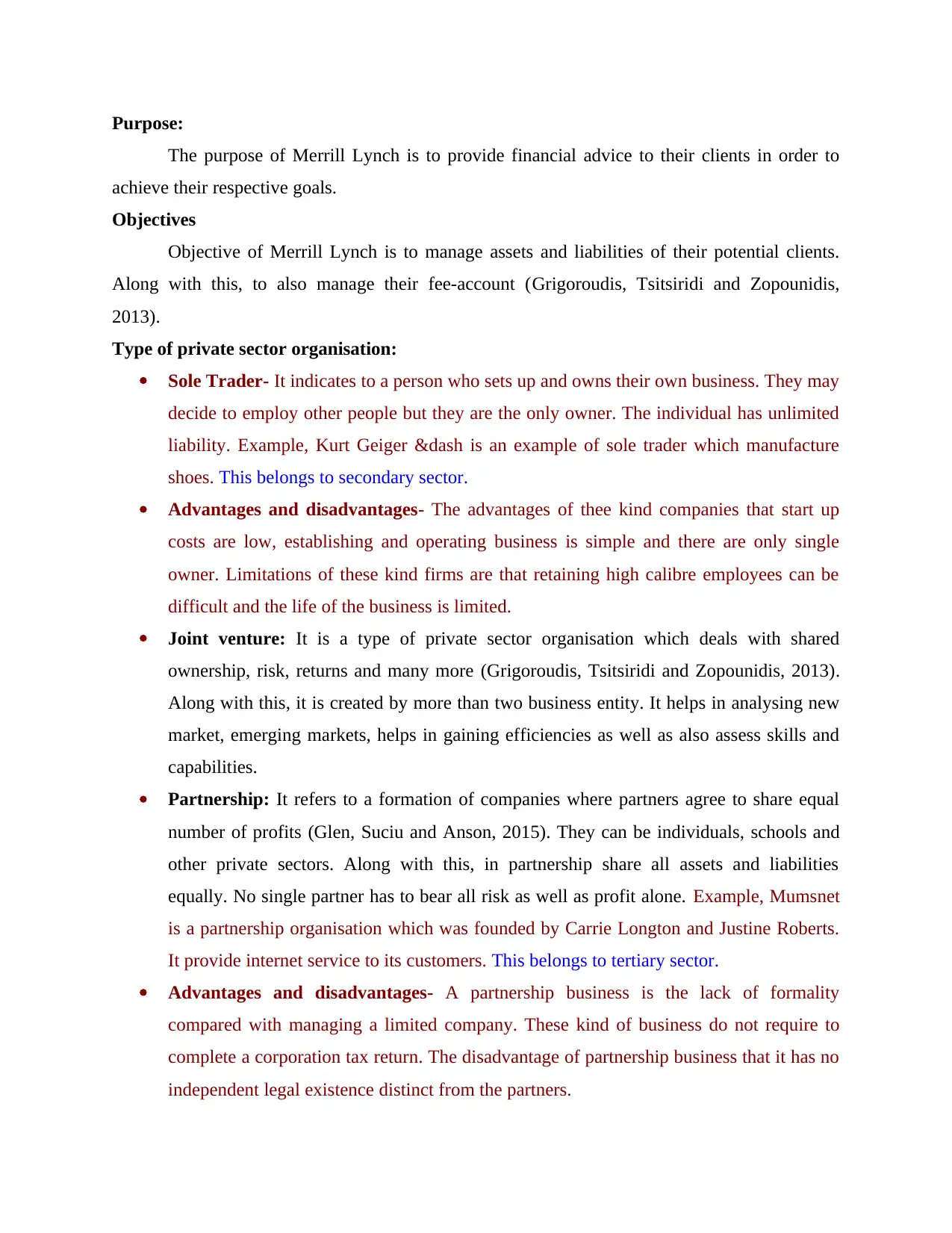
Purpose:
The purpose of Merrill Lynch is to provide financial advice to their clients in order to
achieve their respective goals.
Objectives
Objective of Merrill Lynch is to manage assets and liabilities of their potential clients.
Along with this, to also manage their fee-account (Grigoroudis, Tsitsiridi and Zopounidis,
2013).
Type of private sector organisation:
Sole Trader- It indicates to a person who sets up and owns their own business. They may
decide to employ other people but they are the only owner. The individual has unlimited
liability. Example, Kurt Geiger &dash is an example of sole trader which manufacture
shoes. This belongs to secondary sector.
Advantages and disadvantages- The advantages of thee kind companies that start up
costs are low, establishing and operating business is simple and there are only single
owner. Limitations of these kind firms are that retaining high calibre employees can be
difficult and the life of the business is limited.
Joint venture: It is a type of private sector organisation which deals with shared
ownership, risk, returns and many more (Grigoroudis, Tsitsiridi and Zopounidis, 2013).
Along with this, it is created by more than two business entity. It helps in analysing new
market, emerging markets, helps in gaining efficiencies as well as also assess skills and
capabilities.
Partnership: It refers to a formation of companies where partners agree to share equal
number of profits (Glen, Suciu and Anson, 2015). They can be individuals, schools and
other private sectors. Along with this, in partnership share all assets and liabilities
equally. No single partner has to bear all risk as well as profit alone. Example, Mumsnet
is a partnership organisation which was founded by Carrie Longton and Justine Roberts.
It provide internet service to its customers. This belongs to tertiary sector.
Advantages and disadvantages- A partnership business is the lack of formality
compared with managing a limited company. These kind of business do not require to
complete a corporation tax return. The disadvantage of partnership business that it has no
independent legal existence distinct from the partners.
The purpose of Merrill Lynch is to provide financial advice to their clients in order to
achieve their respective goals.
Objectives
Objective of Merrill Lynch is to manage assets and liabilities of their potential clients.
Along with this, to also manage their fee-account (Grigoroudis, Tsitsiridi and Zopounidis,
2013).
Type of private sector organisation:
Sole Trader- It indicates to a person who sets up and owns their own business. They may
decide to employ other people but they are the only owner. The individual has unlimited
liability. Example, Kurt Geiger &dash is an example of sole trader which manufacture
shoes. This belongs to secondary sector.
Advantages and disadvantages- The advantages of thee kind companies that start up
costs are low, establishing and operating business is simple and there are only single
owner. Limitations of these kind firms are that retaining high calibre employees can be
difficult and the life of the business is limited.
Joint venture: It is a type of private sector organisation which deals with shared
ownership, risk, returns and many more (Grigoroudis, Tsitsiridi and Zopounidis, 2013).
Along with this, it is created by more than two business entity. It helps in analysing new
market, emerging markets, helps in gaining efficiencies as well as also assess skills and
capabilities.
Partnership: It refers to a formation of companies where partners agree to share equal
number of profits (Glen, Suciu and Anson, 2015). They can be individuals, schools and
other private sectors. Along with this, in partnership share all assets and liabilities
equally. No single partner has to bear all risk as well as profit alone. Example, Mumsnet
is a partnership organisation which was founded by Carrie Longton and Justine Roberts.
It provide internet service to its customers. This belongs to tertiary sector.
Advantages and disadvantages- A partnership business is the lack of formality
compared with managing a limited company. These kind of business do not require to
complete a corporation tax return. The disadvantage of partnership business that it has no
independent legal existence distinct from the partners.
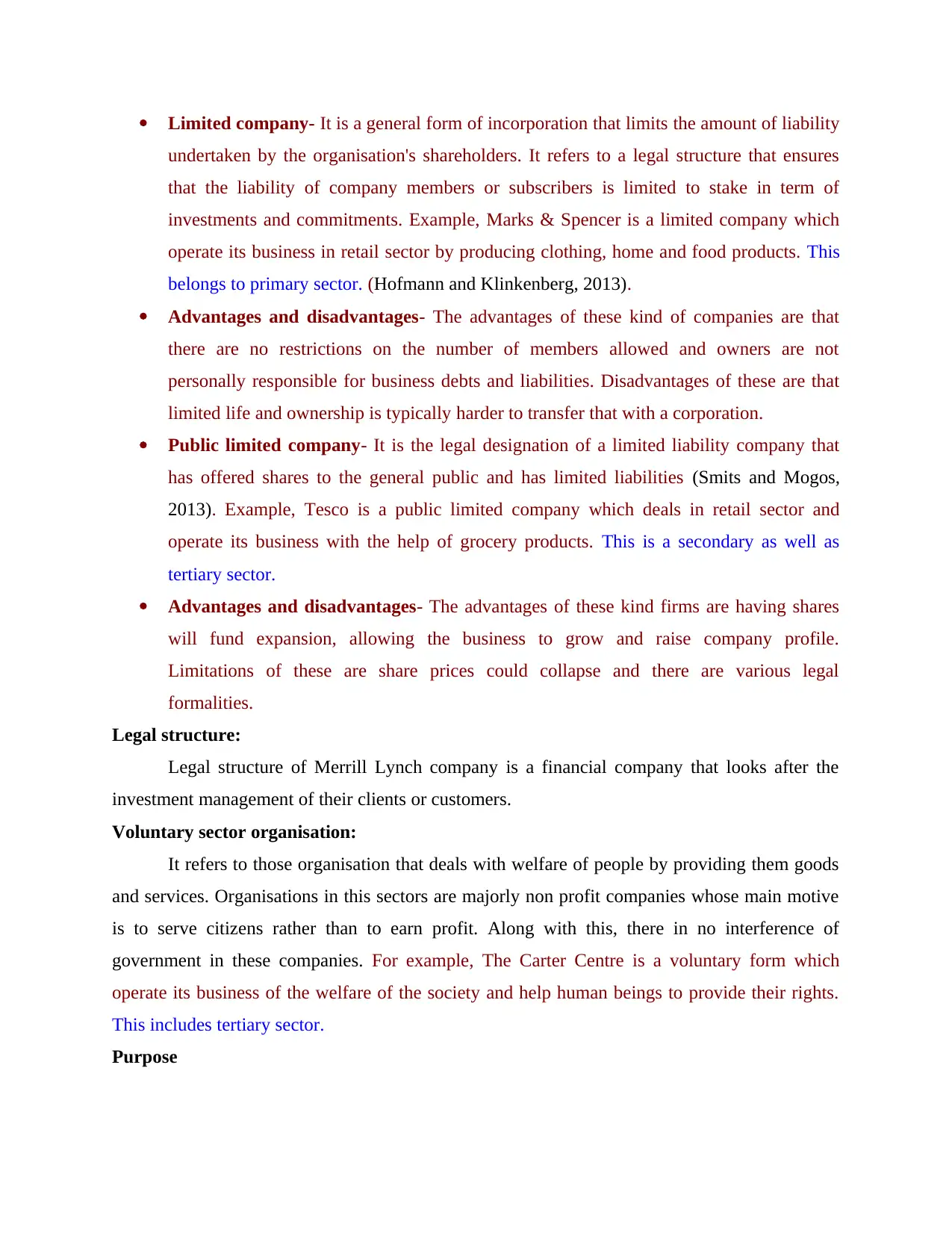
Limited company- It is a general form of incorporation that limits the amount of liability
undertaken by the organisation's shareholders. It refers to a legal structure that ensures
that the liability of company members or subscribers is limited to stake in term of
investments and commitments. Example, Marks & Spencer is a limited company which
operate its business in retail sector by producing clothing, home and food products. This
belongs to primary sector. (Hofmann and Klinkenberg, 2013).
Advantages and disadvantages- The advantages of these kind of companies are that
there are no restrictions on the number of members allowed and owners are not
personally responsible for business debts and liabilities. Disadvantages of these are that
limited life and ownership is typically harder to transfer that with a corporation.
Public limited company- It is the legal designation of a limited liability company that
has offered shares to the general public and has limited liabilities (Smits and Mogos,
2013). Example, Tesco is a public limited company which deals in retail sector and
operate its business with the help of grocery products. This is a secondary as well as
tertiary sector.
Advantages and disadvantages- The advantages of these kind firms are having shares
will fund expansion, allowing the business to grow and raise company profile.
Limitations of these are share prices could collapse and there are various legal
formalities.
Legal structure:
Legal structure of Merrill Lynch company is a financial company that looks after the
investment management of their clients or customers.
Voluntary sector organisation:
It refers to those organisation that deals with welfare of people by providing them goods
and services. Organisations in this sectors are majorly non profit companies whose main motive
is to serve citizens rather than to earn profit. Along with this, there in no interference of
government in these companies. For example, The Carter Centre is a voluntary form which
operate its business of the welfare of the society and help human beings to provide their rights.
This includes tertiary sector.
Purpose
undertaken by the organisation's shareholders. It refers to a legal structure that ensures
that the liability of company members or subscribers is limited to stake in term of
investments and commitments. Example, Marks & Spencer is a limited company which
operate its business in retail sector by producing clothing, home and food products. This
belongs to primary sector. (Hofmann and Klinkenberg, 2013).
Advantages and disadvantages- The advantages of these kind of companies are that
there are no restrictions on the number of members allowed and owners are not
personally responsible for business debts and liabilities. Disadvantages of these are that
limited life and ownership is typically harder to transfer that with a corporation.
Public limited company- It is the legal designation of a limited liability company that
has offered shares to the general public and has limited liabilities (Smits and Mogos,
2013). Example, Tesco is a public limited company which deals in retail sector and
operate its business with the help of grocery products. This is a secondary as well as
tertiary sector.
Advantages and disadvantages- The advantages of these kind firms are having shares
will fund expansion, allowing the business to grow and raise company profile.
Limitations of these are share prices could collapse and there are various legal
formalities.
Legal structure:
Legal structure of Merrill Lynch company is a financial company that looks after the
investment management of their clients or customers.
Voluntary sector organisation:
It refers to those organisation that deals with welfare of people by providing them goods
and services. Organisations in this sectors are majorly non profit companies whose main motive
is to serve citizens rather than to earn profit. Along with this, there in no interference of
government in these companies. For example, The Carter Centre is a voluntary form which
operate its business of the welfare of the society and help human beings to provide their rights.
This includes tertiary sector.
Purpose
⊘ This is a preview!⊘
Do you want full access?
Subscribe today to unlock all pages.

Trusted by 1+ million students worldwide
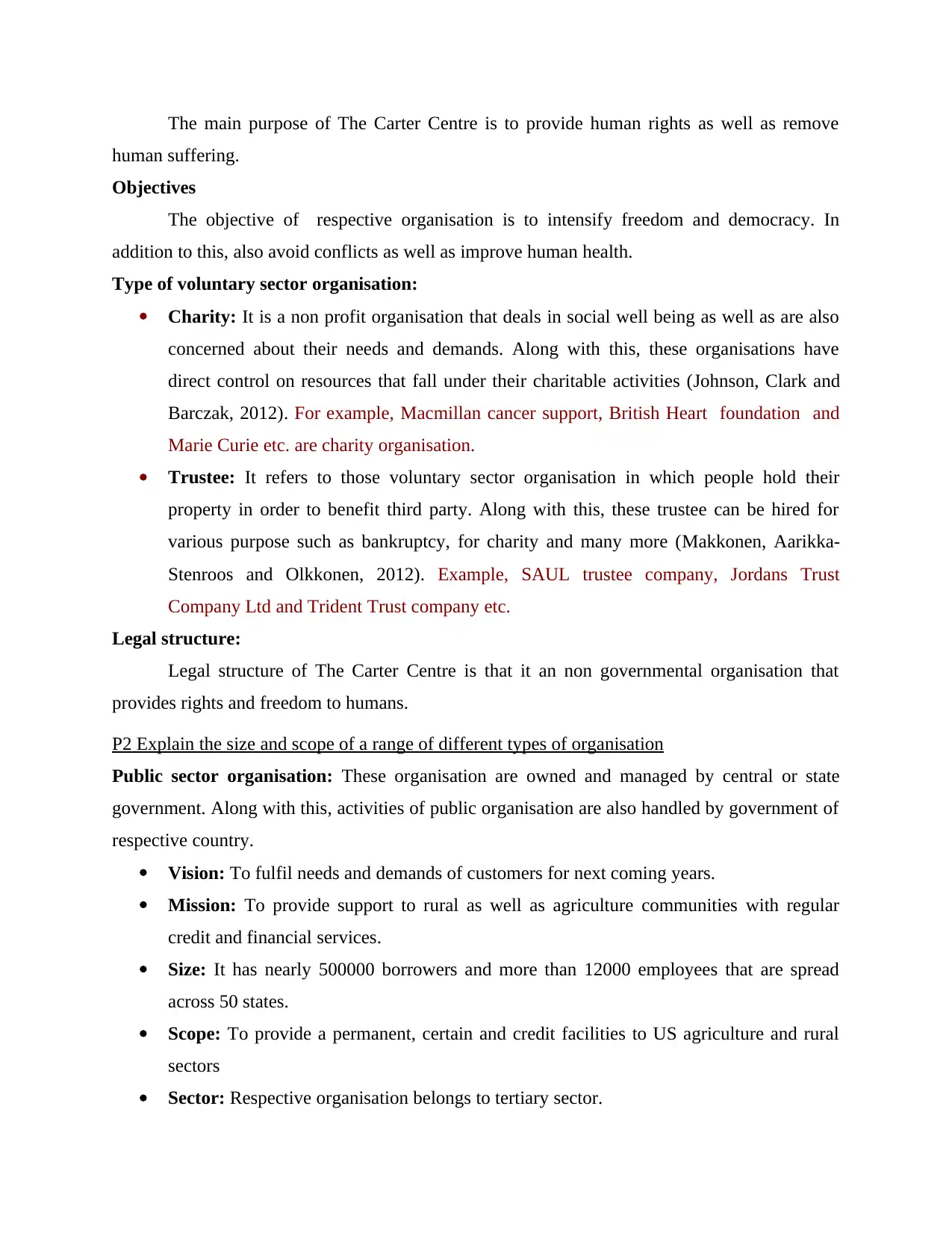
The main purpose of The Carter Centre is to provide human rights as well as remove
human suffering.
Objectives
The objective of respective organisation is to intensify freedom and democracy. In
addition to this, also avoid conflicts as well as improve human health.
Type of voluntary sector organisation:
Charity: It is a non profit organisation that deals in social well being as well as are also
concerned about their needs and demands. Along with this, these organisations have
direct control on resources that fall under their charitable activities (Johnson, Clark and
Barczak, 2012). For example, Macmillan cancer support, British Heart foundation and
Marie Curie etc. are charity organisation.
Trustee: It refers to those voluntary sector organisation in which people hold their
property in order to benefit third party. Along with this, these trustee can be hired for
various purpose such as bankruptcy, for charity and many more (Makkonen, Aarikka-
Stenroos and Olkkonen, 2012). Example, SAUL trustee company, Jordans Trust
Company Ltd and Trident Trust company etc.
Legal structure:
Legal structure of The Carter Centre is that it an non governmental organisation that
provides rights and freedom to humans.
P2 Explain the size and scope of a range of different types of organisation
Public sector organisation: These organisation are owned and managed by central or state
government. Along with this, activities of public organisation are also handled by government of
respective country.
Vision: To fulfil needs and demands of customers for next coming years.
Mission: To provide support to rural as well as agriculture communities with regular
credit and financial services.
Size: It has nearly 500000 borrowers and more than 12000 employees that are spread
across 50 states.
Scope: To provide a permanent, certain and credit facilities to US agriculture and rural
sectors
Sector: Respective organisation belongs to tertiary sector.
human suffering.
Objectives
The objective of respective organisation is to intensify freedom and democracy. In
addition to this, also avoid conflicts as well as improve human health.
Type of voluntary sector organisation:
Charity: It is a non profit organisation that deals in social well being as well as are also
concerned about their needs and demands. Along with this, these organisations have
direct control on resources that fall under their charitable activities (Johnson, Clark and
Barczak, 2012). For example, Macmillan cancer support, British Heart foundation and
Marie Curie etc. are charity organisation.
Trustee: It refers to those voluntary sector organisation in which people hold their
property in order to benefit third party. Along with this, these trustee can be hired for
various purpose such as bankruptcy, for charity and many more (Makkonen, Aarikka-
Stenroos and Olkkonen, 2012). Example, SAUL trustee company, Jordans Trust
Company Ltd and Trident Trust company etc.
Legal structure:
Legal structure of The Carter Centre is that it an non governmental organisation that
provides rights and freedom to humans.
P2 Explain the size and scope of a range of different types of organisation
Public sector organisation: These organisation are owned and managed by central or state
government. Along with this, activities of public organisation are also handled by government of
respective country.
Vision: To fulfil needs and demands of customers for next coming years.
Mission: To provide support to rural as well as agriculture communities with regular
credit and financial services.
Size: It has nearly 500000 borrowers and more than 12000 employees that are spread
across 50 states.
Scope: To provide a permanent, certain and credit facilities to US agriculture and rural
sectors
Sector: Respective organisation belongs to tertiary sector.
Paraphrase This Document
Need a fresh take? Get an instant paraphrase of this document with our AI Paraphraser

Private sector organisation: These organisation are handled by individuals, companies or other
sectors that are not under control of government.
Vision: To provide quality products and services to their clients and also fulfil their needs
and demands.
Mission: Mission of Merrill Lynch is to provide them strategies that will help their
clients to attain their specific needs.
Size: The size of Merrill Lynch is approx 15000 financial advisors worldwide (Tukker
and Tischner, 2017).
Scope: To attract customers so that they invest their funds in respective company and
also provide them best financial advices.
Sector: Private sector organisation operating their business in tertiary sector.
Voluntary sector organisation: It is define as those organisation which is concerned about
welfare of people and provide them their human rights (Sampaio, Thomas and Font, 2012).
Vision: To prevents conflicts as well as measure outcomes and accent actions.
Mission: To encounter the problem in difficult situation and also recognize chances of
failures at acceptable risk.
Size: It has approx 170 employees that are in field of office staff.
Scope: To provide all necessities that is required by humans and also provide them health
facilities.
Sector:Voluntary sector organisation is conducting its business operations at tertiary
sector.
Advantages and Disadvantages of tertiary sector:
Advantages:
It incurs low cost for start-ups and also does not require last amount of inventory as well
as manufacturing (Makkonen, Aarikka and Olkkonen, 2012).
This sector can adopt itself according to dynamic environment as well as it can be
operated in local market.
Disadvantages:
It does not have more value than primary and secondary sector because these sectors
require raw materials, manufacturing and other activities.
sectors that are not under control of government.
Vision: To provide quality products and services to their clients and also fulfil their needs
and demands.
Mission: Mission of Merrill Lynch is to provide them strategies that will help their
clients to attain their specific needs.
Size: The size of Merrill Lynch is approx 15000 financial advisors worldwide (Tukker
and Tischner, 2017).
Scope: To attract customers so that they invest their funds in respective company and
also provide them best financial advices.
Sector: Private sector organisation operating their business in tertiary sector.
Voluntary sector organisation: It is define as those organisation which is concerned about
welfare of people and provide them their human rights (Sampaio, Thomas and Font, 2012).
Vision: To prevents conflicts as well as measure outcomes and accent actions.
Mission: To encounter the problem in difficult situation and also recognize chances of
failures at acceptable risk.
Size: It has approx 170 employees that are in field of office staff.
Scope: To provide all necessities that is required by humans and also provide them health
facilities.
Sector:Voluntary sector organisation is conducting its business operations at tertiary
sector.
Advantages and Disadvantages of tertiary sector:
Advantages:
It incurs low cost for start-ups and also does not require last amount of inventory as well
as manufacturing (Makkonen, Aarikka and Olkkonen, 2012).
This sector can adopt itself according to dynamic environment as well as it can be
operated in local market.
Disadvantages:
It does not have more value than primary and secondary sector because these sectors
require raw materials, manufacturing and other activities.
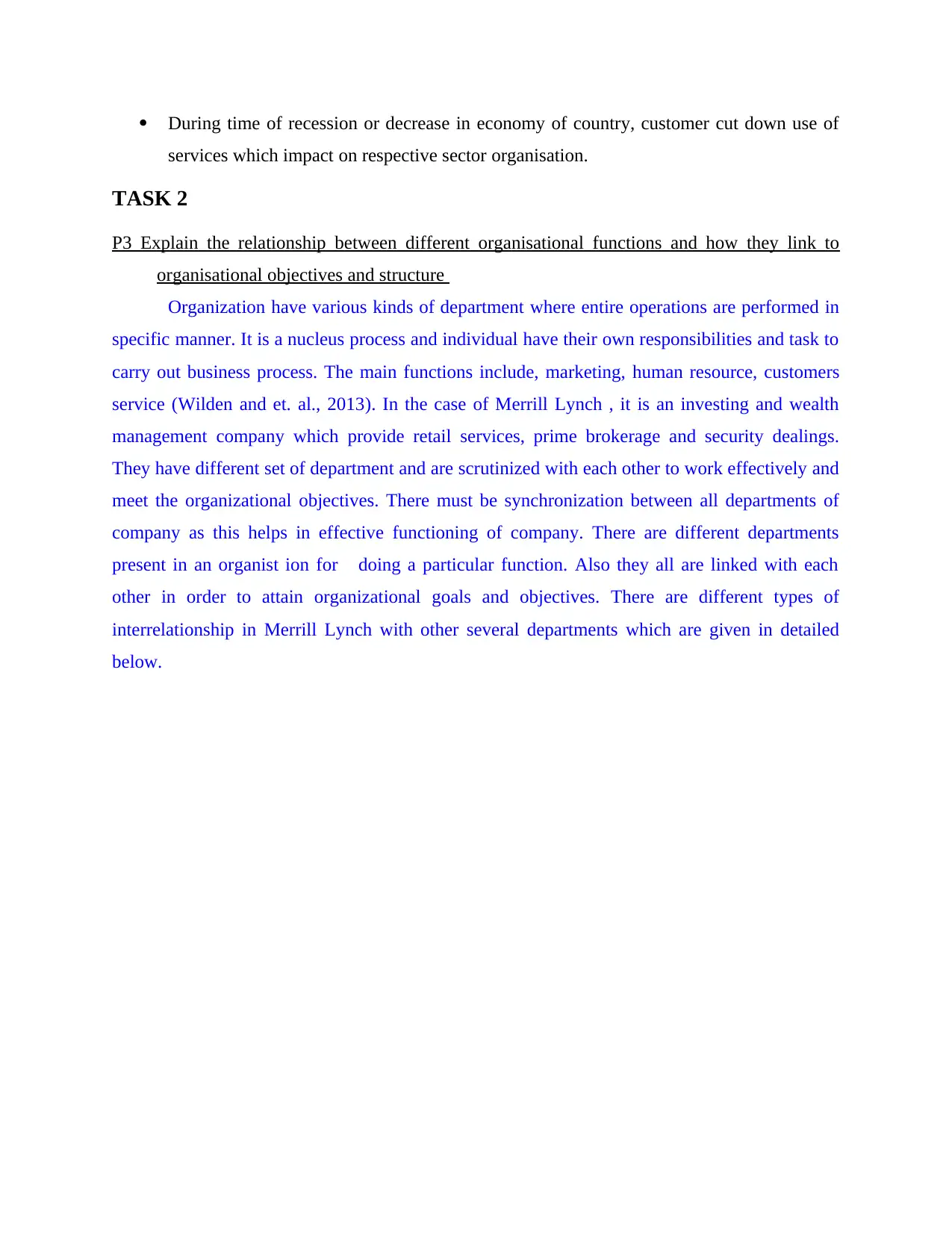
During time of recession or decrease in economy of country, customer cut down use of
services which impact on respective sector organisation.
TASK 2
P3 Explain the relationship between different organisational functions and how they link to
organisational objectives and structure
Organization have various kinds of department where entire operations are performed in
specific manner. It is a nucleus process and individual have their own responsibilities and task to
carry out business process. The main functions include, marketing, human resource, customers
service (Wilden and et. al., 2013). In the case of Merrill Lynch , it is an investing and wealth
management company which provide retail services, prime brokerage and security dealings.
They have different set of department and are scrutinized with each other to work effectively and
meet the organizational objectives. There must be synchronization between all departments of
company as this helps in effective functioning of company. There are different departments
present in an organist ion for doing a particular function. Also they all are linked with each
other in order to attain organizational goals and objectives. There are different types of
interrelationship in Merrill Lynch with other several departments which are given in detailed
below.
services which impact on respective sector organisation.
TASK 2
P3 Explain the relationship between different organisational functions and how they link to
organisational objectives and structure
Organization have various kinds of department where entire operations are performed in
specific manner. It is a nucleus process and individual have their own responsibilities and task to
carry out business process. The main functions include, marketing, human resource, customers
service (Wilden and et. al., 2013). In the case of Merrill Lynch , it is an investing and wealth
management company which provide retail services, prime brokerage and security dealings.
They have different set of department and are scrutinized with each other to work effectively and
meet the organizational objectives. There must be synchronization between all departments of
company as this helps in effective functioning of company. There are different departments
present in an organist ion for doing a particular function. Also they all are linked with each
other in order to attain organizational goals and objectives. There are different types of
interrelationship in Merrill Lynch with other several departments which are given in detailed
below.
⊘ This is a preview!⊘
Do you want full access?
Subscribe today to unlock all pages.

Trusted by 1+ million students worldwide

Every organisation have different department such as marketing, finance, human resource
and many more (Verbeke, 2013). These department are inter related with each other so that
organisation functions and operations can work effectively. Along with this, in the absence of
any department in a company can directly or indirectly affect the functioning of the organisation.
The inter relation between various department are explained below:
Finance and Marketing department: The respective two department are interrelated
with each other. In context of Merrill Lynch firm, as it is a investment company it require
support of both finance and marketing department (Weathington, Cunningham and
Pittenger, 2012). This is because with the help of finance department, respective
organisation can organise sufficient amount of funds. These funds will assist the
marketing department to promote the services of organisation in the form of
advertisement in newspapers, magazines, television and other media sources. This will
help company to attract customer in order to sell their services to them. Along with this,
they will also build their relation with them as well as gain their trust.
Ill
ustration 1: Form FWP Merrill Lynch Mortgage Investors Trust, Series
2007-he1.
(Source: Form FWP Merrill Lynch Mortgage Investors Trust, Series 2007-
he1, 2019)
and many more (Verbeke, 2013). These department are inter related with each other so that
organisation functions and operations can work effectively. Along with this, in the absence of
any department in a company can directly or indirectly affect the functioning of the organisation.
The inter relation between various department are explained below:
Finance and Marketing department: The respective two department are interrelated
with each other. In context of Merrill Lynch firm, as it is a investment company it require
support of both finance and marketing department (Weathington, Cunningham and
Pittenger, 2012). This is because with the help of finance department, respective
organisation can organise sufficient amount of funds. These funds will assist the
marketing department to promote the services of organisation in the form of
advertisement in newspapers, magazines, television and other media sources. This will
help company to attract customer in order to sell their services to them. Along with this,
they will also build their relation with them as well as gain their trust.
Ill
ustration 1: Form FWP Merrill Lynch Mortgage Investors Trust, Series
2007-he1.
(Source: Form FWP Merrill Lynch Mortgage Investors Trust, Series 2007-
he1, 2019)
Paraphrase This Document
Need a fresh take? Get an instant paraphrase of this document with our AI Paraphraser

Marketing and HR department: Marketing and HR department are co-related to each
other. In respect of Merrill Lynch organisation, majorly respective company focus on
recruiting candidates who are well trained and have knowledge in the field of finance
(Olszak, 2016). So its the duty of marketing department to advertise the ad of vacancy in
respective company and have communication with HR manager in order to hire a
candidate. Along with this, HR department must recruit a candidate that fulfil all the
categories as per the organisation needs and requirement. In order to accomplish goals
and objectives of respective company both department must effectively work with each
other as well as have good communication among them.
Sales Department and Marketing Department : It has the direct tie up with company
product and service and sale person also deals with the respective customers. It is
important for a company to have effective sales team fort generating high volumes of
sales. This department focus on the aspect of sales techniques and also manage the sales
activities in a company. A trained employee which pitch the sales for organisation and
have knowledge of ins and outs of their needs. Sales department have direct relationship
with marketing team and work together for a business and communication is important
for both the department for smooth functioning. Marketing department with the
assistance of attractive marketing strategies aid sales department to increase their overall
sales target, while sales department provide sources to marketing department within
which this department can conduct their marketing functions. This will effectively aid
Merrill Lynch to achieve organisational goals.
HR and Finance department: The another inter relation between organisation
department is HR and Finance. In regards of Merrill Lynch, the company require a
candidate who is well trained and developed in the field of finance and has a experience
of at least 2 years. As per the need and requirement of organisation its the responsibility
of HR department to recruit and select the candidate as pet the skills required by
respective firm and for this they need aid of finance department. This is because the
process of recruitment and selection required lot of funds.
As per the above discussion, it has been analyzed that, all the department in Merrill
Lynch are interconnected to each other. To increase efficiency of company, these departments
must have a seemly communication within themselves which will improve the productivity of
other. In respect of Merrill Lynch organisation, majorly respective company focus on
recruiting candidates who are well trained and have knowledge in the field of finance
(Olszak, 2016). So its the duty of marketing department to advertise the ad of vacancy in
respective company and have communication with HR manager in order to hire a
candidate. Along with this, HR department must recruit a candidate that fulfil all the
categories as per the organisation needs and requirement. In order to accomplish goals
and objectives of respective company both department must effectively work with each
other as well as have good communication among them.
Sales Department and Marketing Department : It has the direct tie up with company
product and service and sale person also deals with the respective customers. It is
important for a company to have effective sales team fort generating high volumes of
sales. This department focus on the aspect of sales techniques and also manage the sales
activities in a company. A trained employee which pitch the sales for organisation and
have knowledge of ins and outs of their needs. Sales department have direct relationship
with marketing team and work together for a business and communication is important
for both the department for smooth functioning. Marketing department with the
assistance of attractive marketing strategies aid sales department to increase their overall
sales target, while sales department provide sources to marketing department within
which this department can conduct their marketing functions. This will effectively aid
Merrill Lynch to achieve organisational goals.
HR and Finance department: The another inter relation between organisation
department is HR and Finance. In regards of Merrill Lynch, the company require a
candidate who is well trained and developed in the field of finance and has a experience
of at least 2 years. As per the need and requirement of organisation its the responsibility
of HR department to recruit and select the candidate as pet the skills required by
respective firm and for this they need aid of finance department. This is because the
process of recruitment and selection required lot of funds.
As per the above discussion, it has been analyzed that, all the department in Merrill
Lynch are interconnected to each other. To increase efficiency of company, these departments
must have a seemly communication within themselves which will improve the productivity of
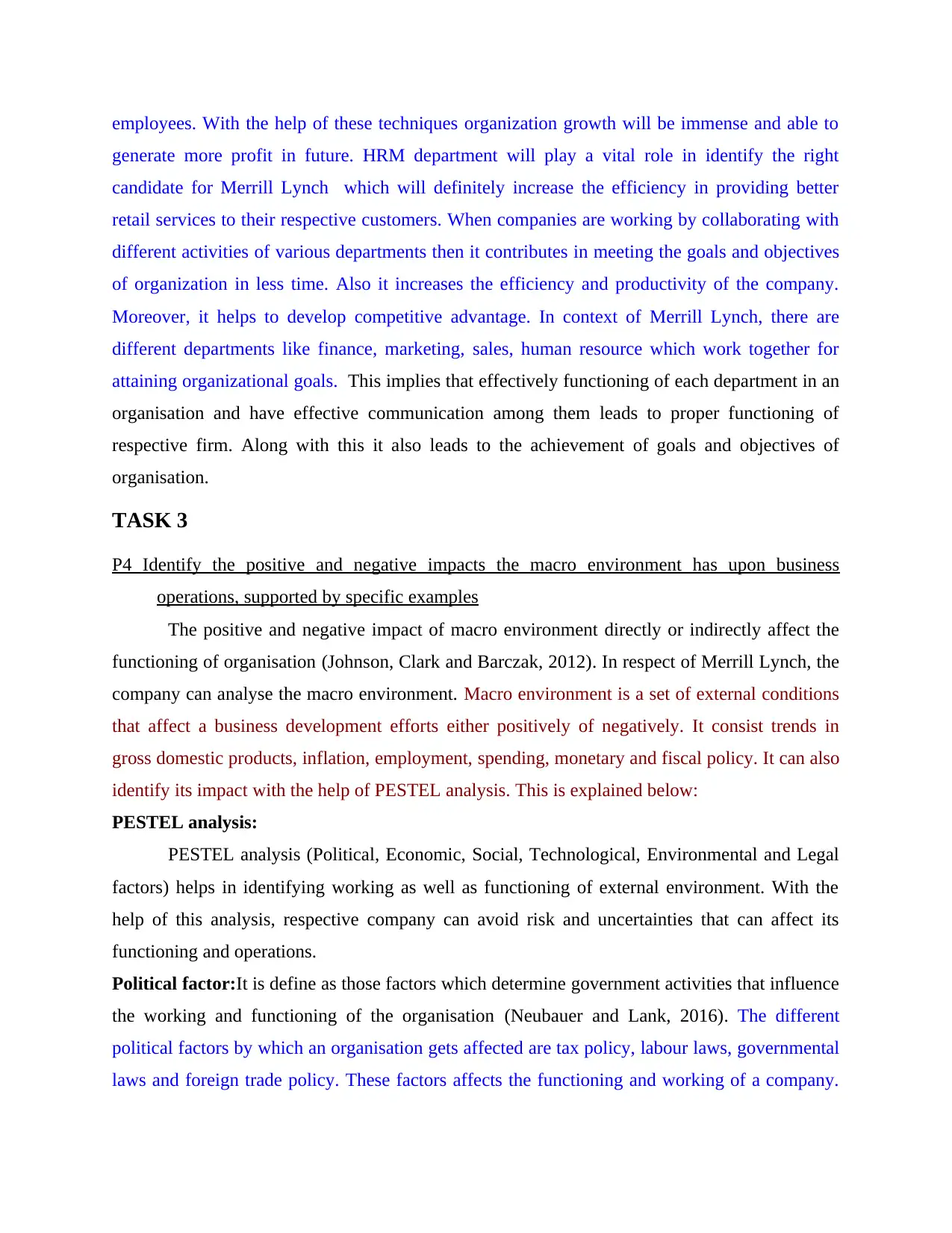
employees. With the help of these techniques organization growth will be immense and able to
generate more profit in future. HRM department will play a vital role in identify the right
candidate for Merrill Lynch which will definitely increase the efficiency in providing better
retail services to their respective customers. When companies are working by collaborating with
different activities of various departments then it contributes in meeting the goals and objectives
of organization in less time. Also it increases the efficiency and productivity of the company.
Moreover, it helps to develop competitive advantage. In context of Merrill Lynch, there are
different departments like finance, marketing, sales, human resource which work together for
attaining organizational goals. This implies that effectively functioning of each department in an
organisation and have effective communication among them leads to proper functioning of
respective firm. Along with this it also leads to the achievement of goals and objectives of
organisation.
TASK 3
P4 Identify the positive and negative impacts the macro environment has upon business
operations, supported by specific examples
The positive and negative impact of macro environment directly or indirectly affect the
functioning of organisation (Johnson, Clark and Barczak, 2012). In respect of Merrill Lynch, the
company can analyse the macro environment. Macro environment is a set of external conditions
that affect a business development efforts either positively of negatively. It consist trends in
gross domestic products, inflation, employment, spending, monetary and fiscal policy. It can also
identify its impact with the help of PESTEL analysis. This is explained below:
PESTEL analysis:
PESTEL analysis (Political, Economic, Social, Technological, Environmental and Legal
factors) helps in identifying working as well as functioning of external environment. With the
help of this analysis, respective company can avoid risk and uncertainties that can affect its
functioning and operations.
Political factor:It is define as those factors which determine government activities that influence
the working and functioning of the organisation (Neubauer and Lank, 2016). The different
political factors by which an organisation gets affected are tax policy, labour laws, governmental
laws and foreign trade policy. These factors affects the functioning and working of a company.
generate more profit in future. HRM department will play a vital role in identify the right
candidate for Merrill Lynch which will definitely increase the efficiency in providing better
retail services to their respective customers. When companies are working by collaborating with
different activities of various departments then it contributes in meeting the goals and objectives
of organization in less time. Also it increases the efficiency and productivity of the company.
Moreover, it helps to develop competitive advantage. In context of Merrill Lynch, there are
different departments like finance, marketing, sales, human resource which work together for
attaining organizational goals. This implies that effectively functioning of each department in an
organisation and have effective communication among them leads to proper functioning of
respective firm. Along with this it also leads to the achievement of goals and objectives of
organisation.
TASK 3
P4 Identify the positive and negative impacts the macro environment has upon business
operations, supported by specific examples
The positive and negative impact of macro environment directly or indirectly affect the
functioning of organisation (Johnson, Clark and Barczak, 2012). In respect of Merrill Lynch, the
company can analyse the macro environment. Macro environment is a set of external conditions
that affect a business development efforts either positively of negatively. It consist trends in
gross domestic products, inflation, employment, spending, monetary and fiscal policy. It can also
identify its impact with the help of PESTEL analysis. This is explained below:
PESTEL analysis:
PESTEL analysis (Political, Economic, Social, Technological, Environmental and Legal
factors) helps in identifying working as well as functioning of external environment. With the
help of this analysis, respective company can avoid risk and uncertainties that can affect its
functioning and operations.
Political factor:It is define as those factors which determine government activities that influence
the working and functioning of the organisation (Neubauer and Lank, 2016). The different
political factors by which an organisation gets affected are tax policy, labour laws, governmental
laws and foreign trade policy. These factors affects the functioning and working of a company.
⊘ This is a preview!⊘
Do you want full access?
Subscribe today to unlock all pages.

Trusted by 1+ million students worldwide
1 out of 21
Related Documents
Your All-in-One AI-Powered Toolkit for Academic Success.
+13062052269
info@desklib.com
Available 24*7 on WhatsApp / Email
![[object Object]](/_next/static/media/star-bottom.7253800d.svg)
Unlock your academic potential
Copyright © 2020–2025 A2Z Services. All Rights Reserved. Developed and managed by ZUCOL.





